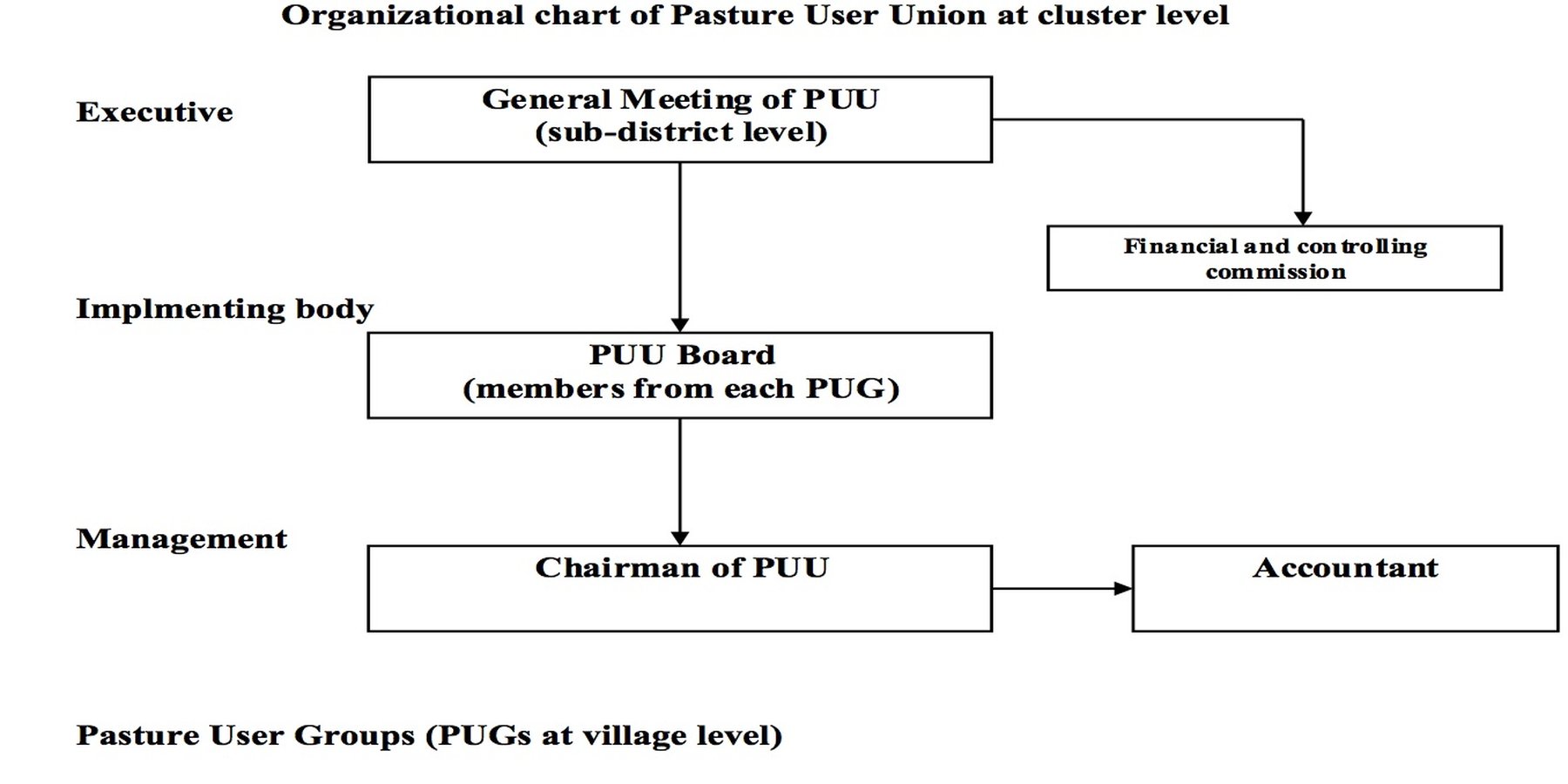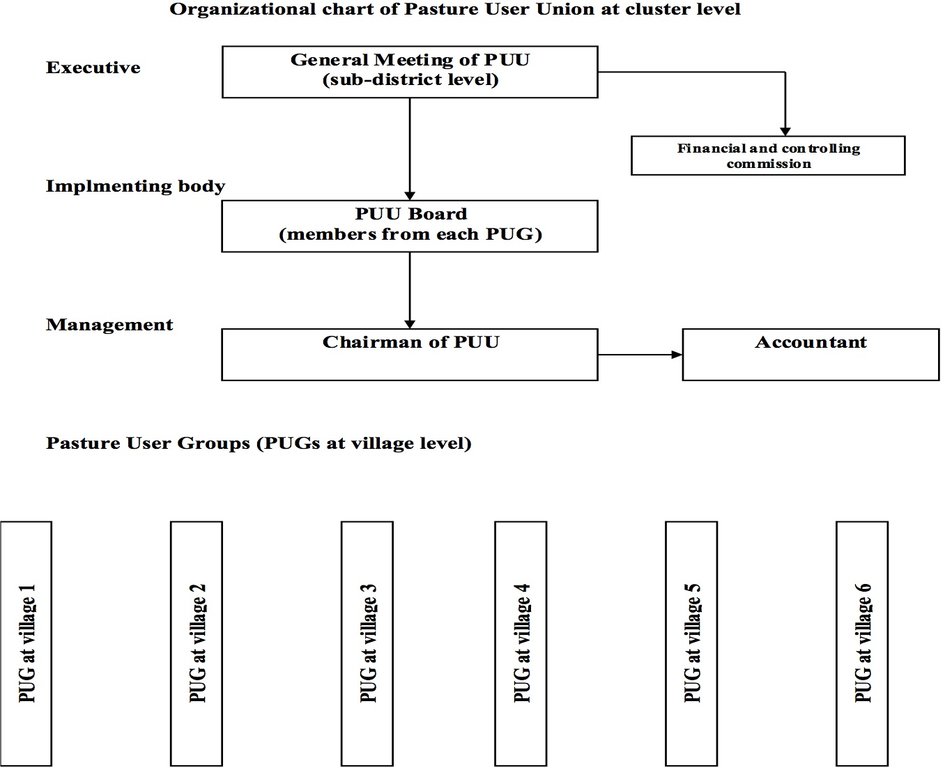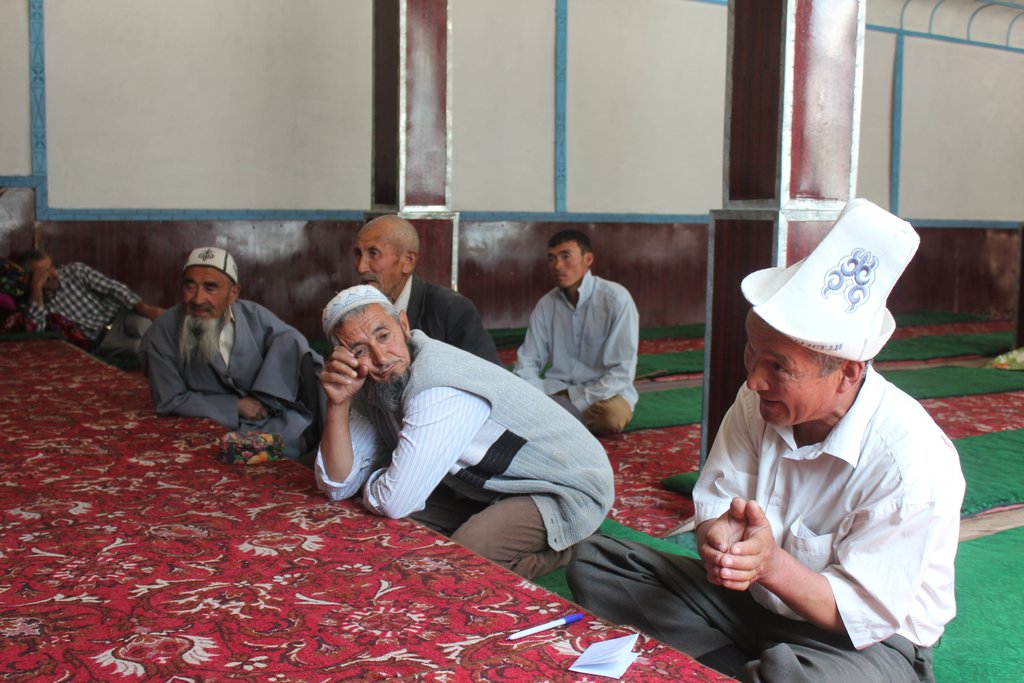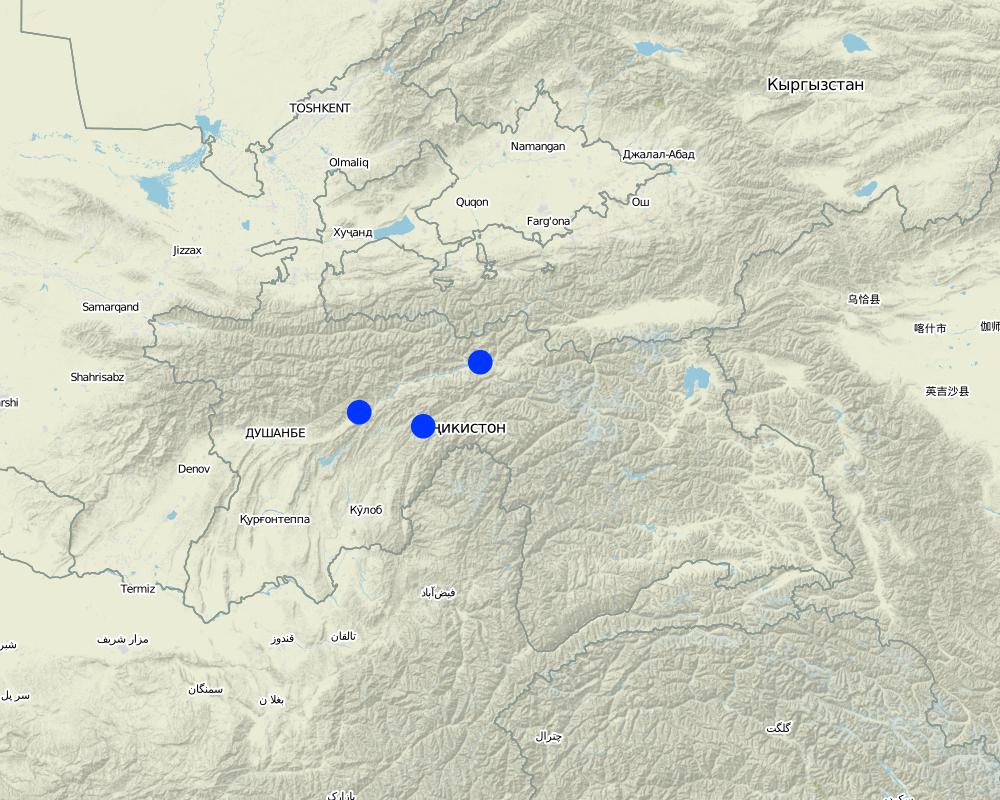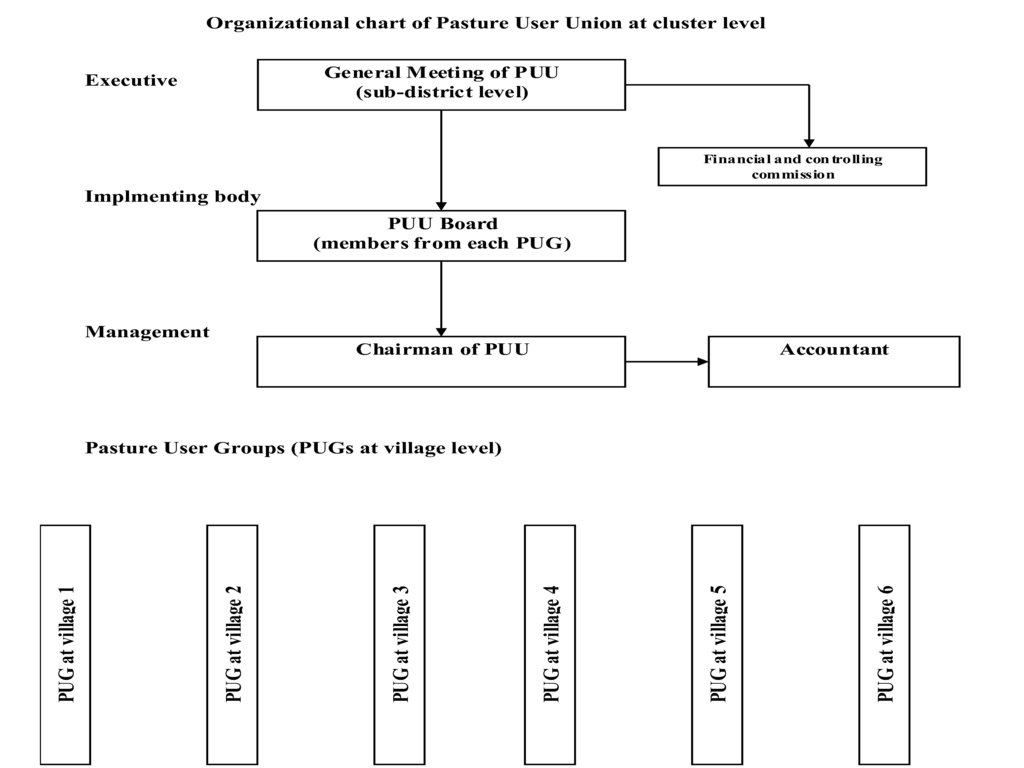Cluster Level Pasture User Union [塔吉克斯坦]
- 创建:
- 更新:
- 编制者: Askarsho Zevarshoev
- 编辑者: –
- 审查者: Yacime Khadraoui, Maximilian Knoll
Чамъияти Чарогохистифодабарандагон дар сатхи кластер
approaches_3443 - 塔吉克斯坦
查看章节
全部展开 全部收起1. 一般信息
1.2 参与方法评估和文件编制的资源人员和机构的联系方式
1.3 关于使用通过WOCAT记录的数据的条件
(现场)数据是什么时候汇编的?:
21/05/2014
编制者和关键资源人员接受有关使用通过WOCAT记录数据的条件。:
是
1.4 SLM技术问卷的参考

Технология управлениия пастбищами в условиях Западного Памира [塔吉克斯坦]
Управление пастбищных угодий путем внедрения новой техники пастбищеоборота с учетом емкости пастбища
- 编制者: Aslam Qadamov
2. SLM方法的描述
2.1 该方法的简要说明
Pasture User Unions (PUUs) at cluster level is consolidating several communities to jointly plan and implement pasture and livestock management related interventions. This approach is supporting to cover big area of pasture lands, which is used by several communities and do not have physical boundaries to define. Therefore joint planning of several communities at cluster level will help communities to meet the need of sustainable pasture and livestock management planning to improve their livelihoods.
2.2 该方法的详细说明
该方法的详细说明:
Pasture User Unions (PUUs) are legally recognized institutional structures under the Law on Pasture of the Republic of Tajikistan (Law of the Republic of Tajikistan on March 19, 2013, #951). Communities and individuals started the establishment of PUUs after the law passed on to organize themselves for better management of their pasture resources. Establishment of PUUs started with introducing development projects immediately after the law passed. The PUU approach had been tested at different levels starting from small units of pasture area, on village level and up to the sub-district level. Under ELMARL project for the purpose for the bigger environmental effects and coverage PUU was tested at cluster level, combining several community level pasture user groups (PUGs) with their representation at cluster level.
The main goal of this approach is to bring several communities under one legal structure for better management of pasture resources, which are interlinked in terms of physical boundaries and social aspects.
The project used participatory methods to bring several villages/communities under one umbrella in the framework of Governmental law on pastures. The planning process for the PUU starts with the first sector on stakeholder analysis, where the main actors are identified. The main stakeholders are community based organizations or village organizations, which also include livestock owners who become members of the PUU, land users of dehkan farms (peasant farms), which are the owners of the pasture/land resources, local governments and their related departments (e.g. land committee, agricultural department, environmental department).
Community based organizations/village organizations are community level structures, which come together to form their legal structure at higher levels for better management of pasture resources. Land/pasture users are the main actors which are responsible for day to day use of the pasture and implementation of technologies and local governments, that takes a leading role in distribution of land and facilitating the process of land use in the area. The majority of community members did like the approach when it was introduced and the purpose was explained, because it contributes to a more sustainable use of their resources. Only those livestock owners that own a big number of livestock are not willing to become part of the PUUs and to participate in the sustainable management of pasture resource. This is because they own big areas of pasture by themselves and are not interested to collaborate with the community.
2.3 该方法的照片
关于照片的一般说明:
Livestock owners came together to discuss the possibility of establishing their own community level structure under the Law on Pasture of the Republic of Tajikistan with project experts to explain them the new law and advantages of creating their own institute.
2.5 采用该方法的国家/地区/地点
国家:
塔吉克斯坦
区域/州/省:
Central Asia/Tajikistan/Rasht Valley
有关地点的进一步说明:
Faizobod, Roghun, Lakhsh and sub-ordinate districts
注释:
Under ELMARL project cluster level PUUs had been established in four districts of Rasht Valley, which are Faizobod, Roghun, Tavildara and Lakhsh.
Map
×2.6 该方法的开始和终止日期
若不知道准确的年份,请注明该方法的大致开始日期。:
不到10年前(最近)
注释:
PUUs are still functional in this area.
2.7 方法的类型
- 最近的本地倡议/创新
2.8 该方法的主要目的/目标
Support and empower legal structures with focus on pasture management and livestock development according to the Pasture Law of the Republic of Tajikistan.
2.9 推动或妨碍实施本办法所适用的技术的条件
社会/文化/宗教规范和价值观
- 启动
Traditionally communities are involved in the management of their pasture resources, previously based on traditional structure, therefore the proposed approach is socially and culturally applicable and well perceived by communities.
财务资源和服务的可用性/可得性
- 阻碍
only project based, further depends on community and PUU leadership, how active they are
机构设置
- 启动
The PUU is a legal structure according to the pasture law.
参与者的的协作/协调
- 启动
All partners and stakeholders are involved in managing the PUU.
法律框架(土地使用权、土地和水使用权)
- 启动
gives rights to the PUU to own the pasture lands
土地治理(决策、实施和执行)
- 启动
Once the land and pasture resources are owned by PUU they are legally enabled to make their own decisions on the use and management of the resources according to the existing laws and regulations.
了解SLM,获得技术支持
- 启动
helps communities and PUU to implement diverse technologies in management and improvement of the pasture lands
市场(购买投入,销售产品)和价格
- 阻碍
Marketing issues are not targeted.
工作量、人力资源可用性
- 阻碍
Because of the high volume of migration some of the management and leadership teams can migrate and hinder the availability of management. Youth is mainly in migration therefore hindering the availability of manpower.
3. 相关利益相关者的参与和角色
3.1 该方法涉及的利益相关者及其职责
- 当地土地使用者/当地社区
members of PUU and livestock owners
are the main actors of the PUU, responsible for overall management of the PUU and day to day activities' implementation with regards to pasture use. They also responsible for the implementation of the pasture plan which is developed jointly with the support of the project technical team.
- 社区组织
village organization, common interest groups, village technology groups
are direct partners of the PUU, which also mobilize communities to join and participate in the pasture management
- SLM专家/农业顾问
project technical team
well mainly responsible in development of the pasture management plan methodology, capacity building of the pasture users/PUU members and ensure compliance of technical aspects of pasture management with PUU members
- NGO
locally registered Public Organization involved in environmental and natural resource management
in fundraising, introducing the PUU members with innovative technologies and approach
- 地方政府
all departments at local level involved in the management of natural resources like agriculture, environmental protection, land departments, committee of emergency and other
collaborates with PUU and empowers the sector to specify topics and lobby their interests at the district level
- 国家政府(规划者、决策者)
Land Committee, Ministry of Agriculture, Committee on the Environmental protection
empower and lobby their interest at national level, guidance
- 国际组织
all existing in the country, including GIZ, Aga Khan Foundation, World Bank, European Commission, ACTED, Caritas etc.,
support with fund raising, provide guidance and exposure on best practices
3.2 当地土地使用者/当地社区参与该方法的不同阶段
| 当地土地使用者/当地社区的参与 | 指定参与人员并描述活动 | |
|---|---|---|
| 启动/动机 | 外部支持 | PUU members, livestock owners, mobilization of people to come together, support project team with collecting information, participate in the capacity building campaigns |
| 计划 | 互动 | PUU members, livestock owners, active participation in the development of pasture and livestock management plan, participate in the session |
| 实施 | 自我动员 | PUU members and other livestock owners. After the pasture and livestock management plan is approved PUU members with support of the PUU management structure were supported with funding and they have implemented different interventions, like fencing of pasture areas, support livestock owners with seeds to grow fodder, income generating activities like beekeeping. |
| 监测/评估 | 外部支持 | The project team with support of the monitoring and evaluation specialist and technical staff conducted continuos support during the implementation phase. |
3.3 流程图(如可用)
具体说明:
This is the organizational chart of the PUU, specifically those established at the cluster level with involvement of several communities. Members from each community are represented in the board and the board is selecting the management staff. The highest body as executive is the general meeting of the PUU, which consists of all members of the PUU.
作者:
Zevarshoev Askarsho
3.4 有关SLM技术选择的决策
具体说明谁有权决定选择要实施的技术:
- 所有相关参与者,作为参与式方法的一部分
解释:
During the planning process all stakeholder participate and decide on which kind of action to implement, but separately pasture users are also actively implementing their traditional practices.
明确做出决策的依据:
- 对充分记录的SLM知识进行评估(基于证据的决策)
4. 技术支持、能力建设和知识管理
4.1 能力建设/培训
是否为土地使用者/其他利益相关者提供培训?:
是
明确受训人员:
- 土地使用者
如果相关,请说明性别、年龄、地位、种族等。:
mixed, with special focus on equal participation of gender and balanced ages
培训形式:
- 在职
- 示范区域
- 公开会议
- 课程
涵盖的主题:
pasture management, accounting, proposal development, environmental land management
4.2 咨询服务
土地使用者有权使用咨询服务吗?:
是
指明是否提供了咨询服务:
- 在土地使用者的土地上
说明/注释:
During visits to the site by the project team consisting of specialists, advisory service was provided to the PUU members. The project also involved specialists from universities and livestock institute who conducted trainings and also provided advisory services.
4.3 机构强化(组织发展)
是否通过这种方法建立或加强了机构?:
- 是,非常
具体说明机构的强化或建立程度:
- 本地
说明机构、角色和职责、成员等。:
Pasture User Union is a legal institute established at local level, which is mainly involved in the sustainable use and management of pastures and livestock. Almost all livestock owners in the targeted zone become members of the PUU to
具体说明支持类型:
- 财务
- 能力建设/培训
- 设备
提供进一步细节:
All three type of support were provided to the institute, starting from the establishment up to the development of their plan and implementation of this plan.
4.4 监测和评估
监测和评估是该方法的一部分吗?:
是
注释:
Continous monitoring of the project was made by the project team to ensure effective implementation of planned activities.
若是,该文件是否用于监测和评估?:
是
4.5 研究
研究是该方法的一部分吗?
否
5. 融资和外部物质支持
5.1 该方法中SLM组成部分的年度预算
如果不知道准确的年度预算,请给出一个范围:
- 2,000-10,000
注释(例如主要的资助来源/主要捐助者):
Environmental Land Management and Rural Livelihood Project, implemented by the Committee on Environmental Protection of the Republic of Tajikistan
5.2 为土地使用者提供财政/物质支援
土地使用者是否获得实施该技术的财政/物质支持?:
是
如果是,请具体说明支持的类型、条件和提供者:
funding support to facilitate communities to establish their PUU and registration fee under the Law of the Republic of Tajikistan on Pasture Management
5.3 对特定投入的补贴(包括劳动力)
- 设备
| 具体说明哪些投入得到了补贴 | 程度如何 | 对补贴做出具体说明 |
|---|---|---|
| 机械 | 充分融资 | machinery, like tractors, was provided to the PUU for development of their pasture infrastrucutre |
| 工具 | 部分融资 | funding for other interventions like establishment of veterinarian drug store, improvement of pasture etc. |
- 建筑
| 具体说明哪些投入得到了补贴 | 程度如何 | 对补贴做出具体说明 |
|---|---|---|
| 木材 | 部分融资 | funding for procurement of wood for construction of animal shed in the remote pasture |
- 基建
| 具体说明哪些投入得到了补贴 | 程度如何 | 对补贴做出具体说明 |
|---|---|---|
| 道路 | 部分融资 | cost to rent bulldozer, cost for fuel for the machinery to clean and rehabilitate the road |
如果土地使用者的劳动力是一项重要的投入,那么是不是:
- 自愿
5.4 信用
是否根据SLM活动的方法给予信用值?:
否
5.5 其它激励或手段
是否有其他激励措施或工具用于促进SLM技术的实施?:
是
如果是,请具体说明:
Specialized training was provided for the PUU members on the new Pasture Law and community participation in the round table discussion on revision and providing feedback to improvement of pasture law organized by the Pasture Network Secretariat.
6. 影响分析和结论性陈述
6.1 方法的影响
该方法是否有助于当地土地使用者,提高利益相关者的参与度?:
- 否
- 是,很少
- 是,中等
- 是,支持力度很大
First the approach was brought together under one structure to discuss the common issues, which relates to all involved stakeholder. Land users become the owner of legal structure under the law of the government, which empowered them to lobby their interest at the governmental level.
这种方法是否有助于基于证据的决策?:
- 否
- 是,很少
- 是,中等
- 是,支持力度很大
during the process of pasture and livestock management plan development in a participatory manner, where youth and women have also participated
该方法是否帮助土地使用者实施和维护SLM技术?:
- 否
- 是,很少
- 是,中等
- 是,支持力度很大
The approach lead to the development of the pasture and livestock management plan with a specific action plan for implementation. The implementation plan involves different technologies and approach to test and learn for dissemination and replication to other areas.
该方法是否提高了SLM的协调性和成本效益?:
- 否
- 是,很少
- 是,中等
- 是,支持力度很大
Since the approach brought together several communities at cluster level to manage their pasture resources, it required a lot of effort to coordinate the activities among each other in consultation with experts.
该方法是否调动/改善了使用财务资源实施SLM的途径?:
- 否
- 是,很少
- 是,中等
- 是,支持力度很大
As a legal structure the PUU is eligible to apply for any available funding.
该方法是否提高了土地使用者实施土地管理的知识和能力?:
- 否
- 是,很少
- 是,中等
- 是,支持力度很大
After establishment of the PUU, a series of trainings and sharing of experiences were provided to the members to learn from best practices and test them in their area.
该方法是否提高了其他利益相关者的知识和能力?:
- 否
- 是,很少
- 是,中等
- 是,支持力度很大
Through establishment the PUUs their management as an institute conducted meeting with other involved stakeholders and explained them their structure. Other identified stakeholders, like land users from neighbor communities were also invited to the capacity building sessions and trainings.
该方法是否建立/加强了机构、利益相关者之间的合作?:
- 否
- 是,很少
- 是,中等
- 是,支持力度很大
In the action plan of the PUU roles and responsibilities of direct involved stakeholders were defined and their roles to interact with other relevant institutions identified. The approach of participatory planning took all stakeholders interests into consideration.
该方法是否缓解了冲突?:
- 否
- 是,很少
- 是,中等
- 是,支持力度很大
Several communities came together with all stakeholders to talk on the existing challenges and mitigate the possible conflict arising from the use of pasture resources.
该方法是否改善了性别平等并赋予女性权力?:
- 否
- 是,很少
- 是,中等
- 是,支持力度很大
Women's roles in the management of livestock and pasture management were identified and taken into consideration to involve them in the decision making process.
该方法是否改善了阻碍SLM技术实施的土地使用权/用户权问题?:
- 否
- 是,很少
- 是,中等
- 是,支持力度很大
PUU enabled the members to own certain amount of pasture land and have to go through certain procedures to improve the ownership over their land.
该方法是否提高了土地使用者适应气候变化/极端情况和减轻气候相关灾害的能力?:
- 否
- 是,很少
- 是,中等
- 是,支持力度很大
PUU enabled land users and its members to get introduced to the best practices on improvment of pasture management, which also helps them to mitigate the climate change and prevention of possible disasters like landslide and mudflow which is common as a result of pasture degradation
该方法是否会带来就业、收入机会?:
- 否
- 是,很少
- 是,中等
- 是,支持力度很大
With establishment of PUU three people already became official employees of the institute and other got income through implementation of intervention. Once the pasture condition improves, the livestock productivity will also improve and will increase income.
6.2 土地使用者实施SLM的主要动机
- 增加生产
increase pasture productivity and livestock products
- 减少土地退化
PUU to contribute to improve ownership over land resource and prevent overgrazing in the realm of degradation protection
- 降低灾害风险
Pasture degradation usually is mainly caused by land slides and mudflows in this area. Once the condition of pastures is improved, it will also prevent natural hazards.
- 环境意识
As the project mainly focuses on environmental land management the approach considers also improvement of pasture condition to contribute to environmental protection.
6.3 方法活动的可持续性
土地使用者能否维持通过该方法实施的措施(无外部支持的情况下)?:
- 是
若是,请说明如何维持:
The PUU is a legal structure according to the law of the country and empowers the communities to become owner of their pasture resources. Through coordination from the local government there is continuous supervision on the performance of the structure, which contribute to its sustainability.
6.4 该方法的长处/优点
| 土地使用者眼中的长处/优势/机会 |
|---|
| can participate in the decision making, the communities own the resources, have their own structure |
| better opportunities for getting access to financial resources |
| 编制者或其他关键资源人员认为的长处/优势/机会 |
|---|
| owned by communities, legally registered according to the official law on pasture of the country |
| as a legal and community based structure recognized taking into consideration of all stakeholders and involves women and youth into decision making |
6.5 该方法的弱点/缺点以及克服它们的方法
| 编制者或其他关键资源人员认为的弱点/缺点/风险 | 如何克服它们? |
|---|---|
| Comparing to other PUUs established only at one community level it is a more complicated structure and difficult to manage. | empower the community and the PUU leadership in management and leadership skills, more capacity building campaigns |
| Pasture resources owned by separate dekhkan farms, which are also legal structure according to the law | More facilitation processes should be applied to support and empower the PUU to become the full and only owners of the pasture resource. |
7. 参考和链接
7.1 方法/信息来源
- 与SLM专业人员/专家的访谈
through direct interviews with the Implementing Agency technical experts and field facilitators
- 根据报告和其他现有文档进行编译
1
7.3 链接到网络上可用的相关信息
标题/说明:
Pasture Management Networking Platform (PMNP)
URL:
https://pasture.klink.asia/dms/documents/groups/796?page=2
链接和模块
全部展开 全部收起链接

Технология управлениия пастбищами в условиях Западного Памира [塔吉克斯坦]
Управление пастбищных угодий путем внедрения новой техники пастбищеоборота с учетом емкости пастбища
- 编制者: Aslam Qadamov
模块
无模块


